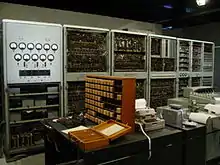Jean-Claude Risset | |
|---|---|
 Risset in 2008 | |
| Born | Jean-Claude Raoul Olivier Risset 13 March 1938 Le Puy-en-Velay, Rhone-Alpes region, France |
| Died | 21 November 2016 (aged 78) Marseille, France |
| Education | École Normale Supérieure, Music theory (1961)[1] |
| Years active | 1961-2011 |
| Employer | Nokia Bell Labs |
| Known for | Computer Music |
Jean-Claude Raoul Olivier Risset (French: [ʁisɛ]; 13 March 1938 – 21 November 2016) was a French composer, best known for his pioneering contributions to computer music. He was a former student of André Jolivet and former co-worker of Max Mathews at Bell Labs.[2][3]
Biography
Risset was born in Le Puy-en-Velay, France. Arriving at Bell Labs, New Jersey in 1964, he used Max Mathews' MUSIC IV software to digitally recreate the sounds of brass instruments. He made digital recordings of trumpets and studied their timbral composition using "pitch-synchronous" spectrum analysis tools, revealing that the amplitude and frequency of the harmonics (more correctly, partials) of these instruments would differ depending on frequency, duration and amplitude. He is also credited with performing the first experiments on a range of synthesis techniques including FM synthesis and waveshaping.[2][3]
After the discrete Shepard scale Risset created a version of the scale where the steps between each tone are continuous, and it is appropriately called the continuous Risset scale or Shepard-Risset glissando.[4]
Risset also created a similar effect with rhythm in which tempo seems to increase or decrease endlessly.[5][6] Risset was the head of the Computer Department at IRCAM (1975–1979). At MIT Media Labs, he composed the first Duet for one pianist (1989).[7] For his work in computer music and his 70 compositions, he received the first Golden Nica (Ars Electronica Prize, 1987), the Giga-Hertz Grand Prize 2009,[8] and the highest French awards in both music (Grand Prix National de la Musique, 1990) and science (Gold Medal, Centre National de la Recherche Scientifique, 1999).[9] and in art (René Dumesnil Prize from the French Academy of Fine Arts, 2011).[10]
Selected works
Vocal music
- Dérives, for choir and magnetic tape (1985) 15'
- Inharmonique, for soprano and tape (1977) 15'
Orchestral music
- Escalas, for large orchestra (2001) 17'
- Mirages, for 16 musicians and tape (1978) 24'
Chamber music
- Profils, for 7 instruments and tape (1983) 18'
- Mutations II for ensemble and electronics (1973) 17'
Solo music
- Trois études en duo, for pianist (bidirectional MIDI piano with computer interaction) (1991) 10'
- Huit esquisses en duo, for pianist (bidirectional MIDI piano with computer interaction) (1989) 17'
- Voilements, for saxophone and tape (1987) 14'
- Passages for flute and tape (1982) 14'
- Variants for violin and digital processing (1995) 8'
Music for solo tape
- Invisible Irène (1995) 12'
- Sud (1985) 24'
- Songes (1979) 10'
- Trois mouvements newtoniens, for tape (1978) 13'
- Mutations (1969) 10'
- Computer Suite from Little Boy (1968) 13'
References
- ↑ "Jean Claude, Resources IRCAM".
- 1 2 "Jean-Claude Risset (biography, works, resources)" (in French and English). IRCAM.
- 1 2 "Jean-Claude Risset (1938-2016)". www.musicologie.org (in French). Retrieved 2018-11-23.
- 1 2 "Jean-Claude Risset, who reimagined digital synthesis, has died – CDM Create Digital Music". CDM Create Digital Music. 2016-11-22. Retrieved 2018-11-23.
The sound for which Risset is best known is perhaps the most emblematic of his contributions. Creating a sonic illusion much like M.C. Escher's optical ones, the Shepherd-Risset glissando / Risset scale, in its present form invented by the French composer, seems to ascend forever.
- ↑ Risset, Jean-Claude (1986), "Pitch and rhythm paradoxes: comments on "Auditory paradox based on fractal waveform"", Journal of the Acoustical Society of America, vol. 80, no. 3, pp. 961–962, doi:10.1121/1.393919, PMID 3760341
- ↑ Stowell, D (2010), "And the beat goes on...forever?", Cs4fn Audio! Magazine, no. 3
- ↑ "News". Computer Music Journal. 41 (2): 7–14. June 2017. doi:10.1162/comj_e_00418. ISSN 0148-9267.
- ↑ "Giga-Hertz Award | 2007 to 2018 | ZKM". Retrieved 2018-11-23.
- ↑ CNRS. "CNRS The National Center for Scientific Research – CNRS Gold medalists". www.cnrs.fr (in French). Archived from the original on 2019-05-03. Retrieved 2018-11-23.
- ↑ "Jean-Claude Risset". brahms.ircam.fr. 27 May 2021. Retrieved 2023-01-18.
Further reading
- Baudouin, Olivier, Pionniers de la musique numérique, Sampzon, Delatour, 2012.
- Portrait polychrome n°2 : Jean-Claude Risset, INA/CDMC Publisher, 2001 (ISBN 2-86938-177-8)

%252C_June_13%252C_2011.jpg.webp)